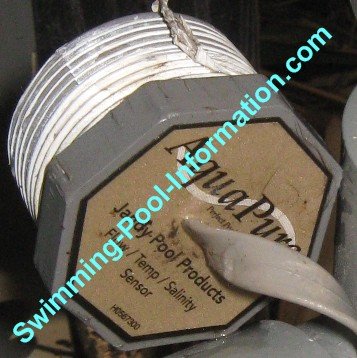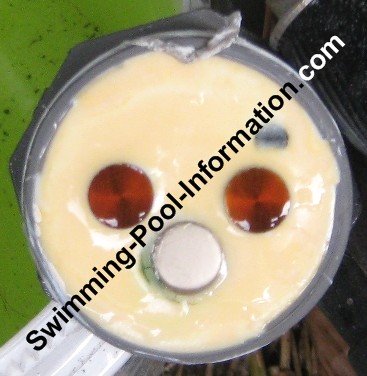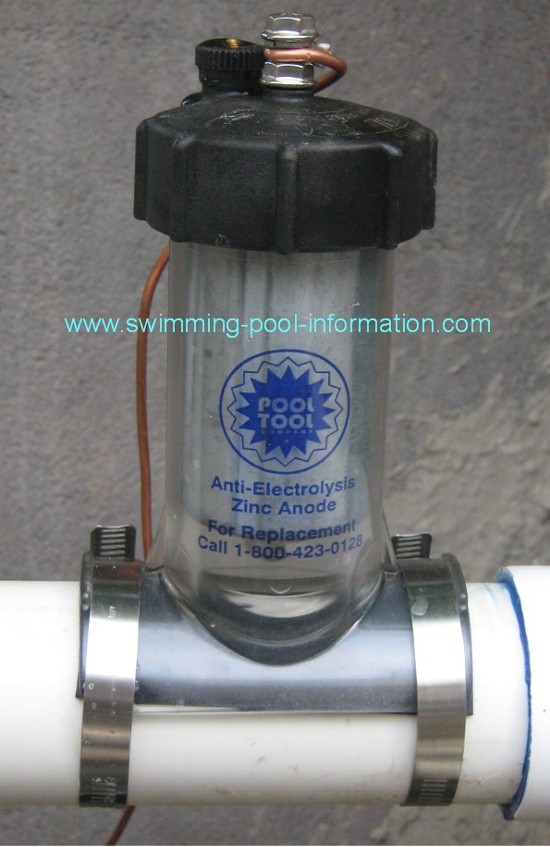Salt Pool Chlorine Generator Problems - Troubleshooting
Incorrect Salt Level (High or Low)
Many chlorine generators will tell you by lights (like the Pentair Intellichlor shown a few photos below) or a numerical reading when salt level is low
1)Is the water temperature cold? At lower water temperatures, some generators can get lower salt readings.
2)A high TDS (Total Dissolved Solids) level from minerals OTHER than salt can sometimes cause the salt level reading to be incorrect. Some sensors work by the electrolysis reading and high levels of minerals can cause a higher electrolysis reading. Salt itself DOES increase TDS level.
3A)Does salt sensor need cleaning?...usually part of the generator cell,but sometimes separate,these sensors need to be acid washed occasionally.
3B)If the salt sensor is a separate item like the Jandy sensor below,sometimes they get cracks in the resin where sensors are located and give erroneous readings.(I have seen a salt reading of 25,000 ppm on a cracked resin sensor)
4)Do you have a leak?...if you have a leak and an automatic pool refill,you may be losing salt and replacing with regular water.
5)Rain - after a big rain,the pool may fill to overflow and dilute salt level.Taking a sample to pool store or testing with salt strips can give you a confirmation - but salt strips can be inaccurate, especially if old.


The Jandy Aquapure sensor shown above top and the sensor or water facing side shown right after soaking in an acid solution. This sensor provides temperature,salinity,and flow readings too. These sensors can give incorrect readings if dirty or scaled.
"Service Cell"
Many generators have a "service cell" light or prompt - this usually means check cell for cleaning. It does NOT necessarily mean something is wrong...just means you need to check cell and reset control.
1A)Sometimes these are on a timed basis like after so many hours of chlorine production. After many hours of operation,you may get calcium build up on the titanium plates and this must be removed usually by acid washing cell. The easiest way to acid wash cell is to get a male capped plug and install on one end of cell so you can pour a water/acid solution into cell like a cup. When the water stops fizzing,the calcium is gone. Some manufacturers recommend using a wooden or plastic scraper instead of acid to prolong plate life - in any case,NEVER use a metal tool such as screwdriver or knife to remove calcium.
1B)Perhaps your PH is too high and causing calcium build up
2)You may have debris in cell blocking water flow or blocking electrical current from flowing through plates.
3)Your water may have a high TDS reading from minerals other than salt such as calcium. If you are having to clean cell too often,it may be time to drain and refill pool.

The salt readings shown on this Pentair Intellichlor cell may not be the ideal level for your particular brand of generator
"Low Flow" or "No Flow"
This error is caused by the flow switch which can be part of the chlorine production cell (Such as the Pentair Intellichlor shown above) or a separate device.
1)Is your filter dirty?
2)Is your pump basket or skimmer basket full?
3)Is the flow switch defective?
4)If you have a non-mechanical flow switch (no moving parts) such as the Jandy AquaPure sensor,they may need acid washing too just like a cell.
5)If you have multi speed pump,generator may not work on the lower speeds (because the lower speed may not activate flow switch).
6)Maybe low flow is due to pump problem - see link below:
Chlorine Generator Appears To Be Working But Chlorine Level Low
1)Is your cyanuric acid (conditioner or stabilizer)level too low? Conditioner helps keep sun rays from degrading chlorine. 60-80 ppm ideal conditioner level.
2)Perhaps generator is set to low setting
3)Maybe pump is not running enough hours to generate enough chlorine (mostly applies to large pools)
4)Is your auto fill running continuously and diluting chlorine/stabilizer?
5)If you have multi-speed pump,your generator may not work on low speed - you may need more hours on high speed.
Metal objects such as pool lights and stainless steel filters seem to be corroding
Electrolysis from cell can slowly attack metal surfaces such as your pool light,stainless steel filter,copper heat exchanger,or other metals such as some automatic cleaner parts.
Most modern pools should have all equipment and pool structure itself bonded to alleviate this problem,but many older pools were bonded by the copper pipe and metallic equipment. But if the copper pipe has been replaced with PVC and/or equipment such as brass pumps have been replaced by composite plastic pumps,the bond has been broken. And stainless steel filters are rarely bonded - they should be tied into bond wire along with this device below - HIGHLY recommended whether or not your filter is steel or if your pool is properly bonded or not:

It protects metals in your pool by easily giving up its ions to electrolysis in the water caused by the current from the salt generator cell. For this reason,it is known as a "sacrificial zinc anode"....as an additional benefit,zinc works in a synergistic mode with chlorine to make sparkling algae free water! Note:the copper wire going to the top of unit is connected to the bonding wire..



